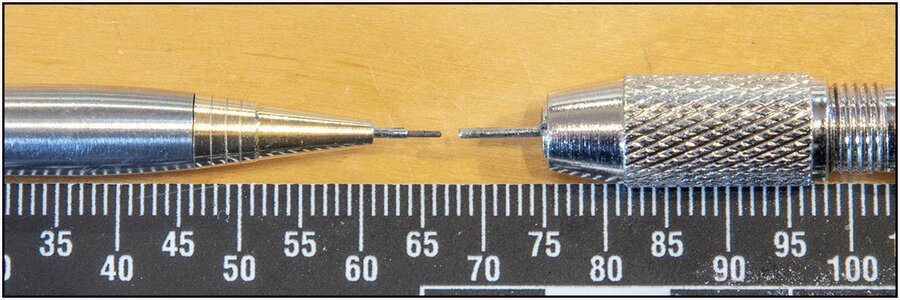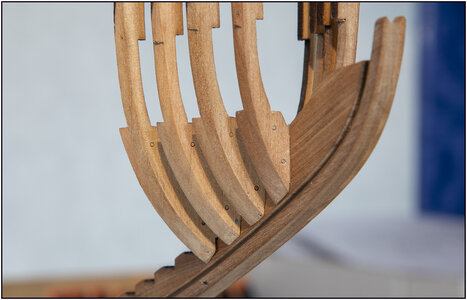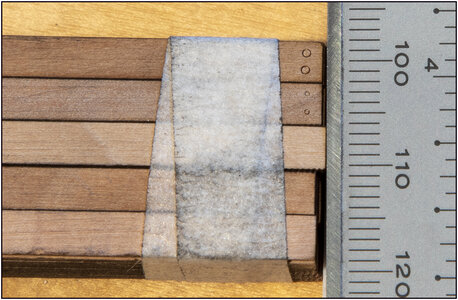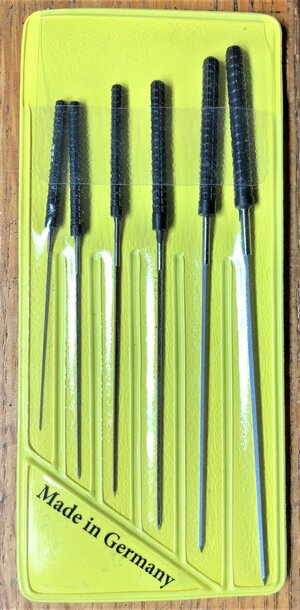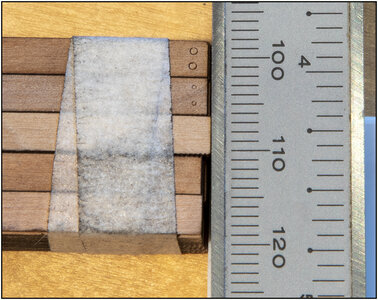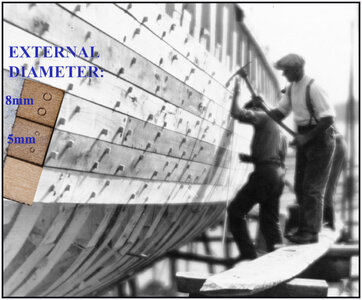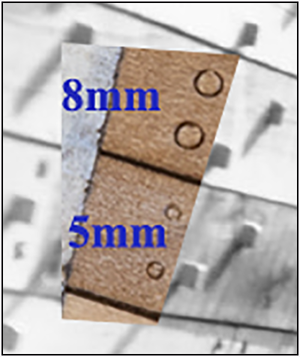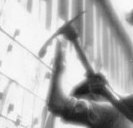Many thanks to all for the interest, it gives me the motivation.
Since the Celling and all Thickstuff will require treenailing the subject for this evening discussion is - Treenail (verb) or imitate treenails or trunnels (you name it) Many methods already discussed, and from time-to-time, a new thread pops up, discussing yet another method as this seems a very 'hot' topic. For years, I am using one of the old methods - actual treenails made from 1 x 1 mm square stock and draw thru a drawplate. I like this method and it is well adapted among Russian modelers, but on the smallest scale it is impossible, well..., almost impossible to draw a 0.4mm treenail stick. But for the scale of 1:48 why not?
First I prepare the timber which I will use for the tests. Thre strips were cut on tablesaw and using my sophisticated sanding machine '
Handxxon' make them the same thickness. I lay all strips n the flat surface on the double-sticky tape (on the ends only) and using the tool made them the same.
View attachment 214187
Then, I glue the black paper to the entire stock. Once dry, using the sharp razor blade slice as individual planks. When I glue the planks, I choose a free pattern. It doesn't reflect a specific shift of the butts pattern, it is rather just for the test.
View attachment 214188 View attachment 214189
The first sample was made from 0.8mm x 5.00mm Castello. I use black paper to simulate caulking. It is divided into three rectangles:
View attachment 214190
Red rectangle: this is the 0.5mm hole and the lead (H) from a mechanical pencil (0.5mm) inserted and lightly twisted
Orange rectangle: this is just treenails from pearwood (no blackening of any kind)
Green rectangle: This is the treenail rod rubbed against graphite powder
Some macro images
View attachment 214191
View attachment 214192
View attachment 214193
Technically the 'red' and 'green' examples look the same, it seems that rubbing the treenail rod against graphite powder just easier than insert the lead into each hole. What I don't like is - a bit of 'fuzziness' around the hole, but this is MACRO, and the bare eye will not see it. The test is planned for the deck planking.
The next set of samples is the 'gamechanger', IMHO. No actual treenails, just imitation!!!! This is something I didn't expect myself. Frankly, I choose the base idea as the method my friend Maarten
@Maarten uses in his Alert build log. Check it out, highly recommend it, with lots of learning materials and great craftsmanship.
Thx again for your comments and likes. Today I am stil working on the thickstuff and shelf clamps. The last three are placed of which the shelf clamp is the most critical. The SB shelfclamp had its wood grain positioned under and angle causing the strake to brake into pieces when steaming and...
shipsofscale.com
So I use the syringe needle with an external diameter of 0.8mm (yellow color) to cut off the yellow head with a cut-off wheel.
View attachment 214202View attachment 214203View attachment 214204
Shaped around the edge to form a sharp-pointed ring. So far the same steps as Maarten did, but that's it. The tool is ready. I tight the needle in my rotary tool and start using it like a drill. The key to success is low speed and no pressure. Start by touching with age, just a bit of angle until it touches the surface, then immediately make it flat against the planks. Don't push too hard, it needs just a touch, otherwise, you will drill thru. With a bit of practice, I am sure you will grasp great results. I absolutely love the results, hope you like them too. It eliminates the need for drawing treenails and drill holes.
This is planned to use for deck planking. The sample below is Pear (it is off-white color). Same caulking techniques as for the above methods - black paper.
View attachment 214195
You will see different results. I was playing with speed and pressure. Also, at some point the working surface gets dull, You don't have to shape it again, just use a polishing paste against the hard felt. A few turns and the tool ready again. Below some MACRO. I love macro, it reveals all the flaws.
View attachment 214196
The last image is the combination of the Pear (will use for Celling) and Swishpear (will use for Thickstuff). This is without oil
View attachment 214201
This is with one coat of Linseed oil. The oil penetrates in grooves and emphasizes the color imitating perfect caulking. Not too dark, not light. For my taste. BTW, all drilling is freehand, I didn't use the pencil to line up, but think, it is a good idea to line up first.
View attachment 214198
...and macro
View attachment 214199
This is how natural Pear looks
View attachment 214200
That's it, for now, folks. It is your turn, and I need your opinion. Which example you like the most and why? Please ask me any question you will come with, I will be glad to answer.
see you soon and thanks for your feedback,


